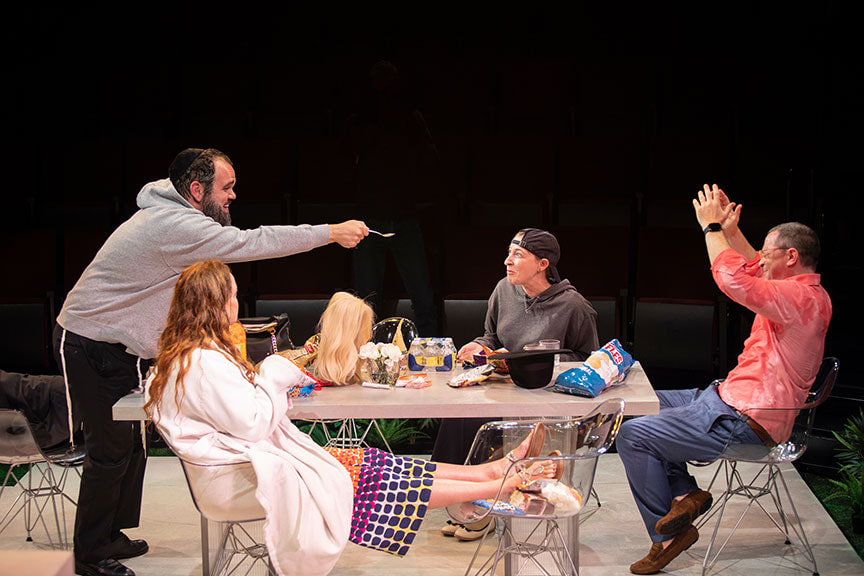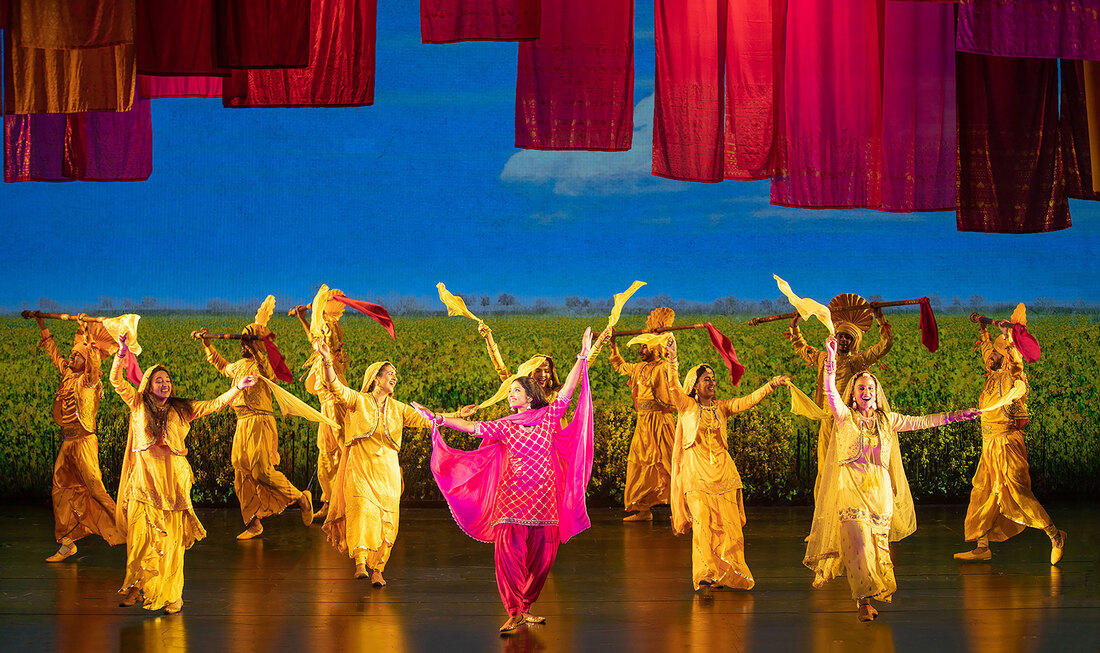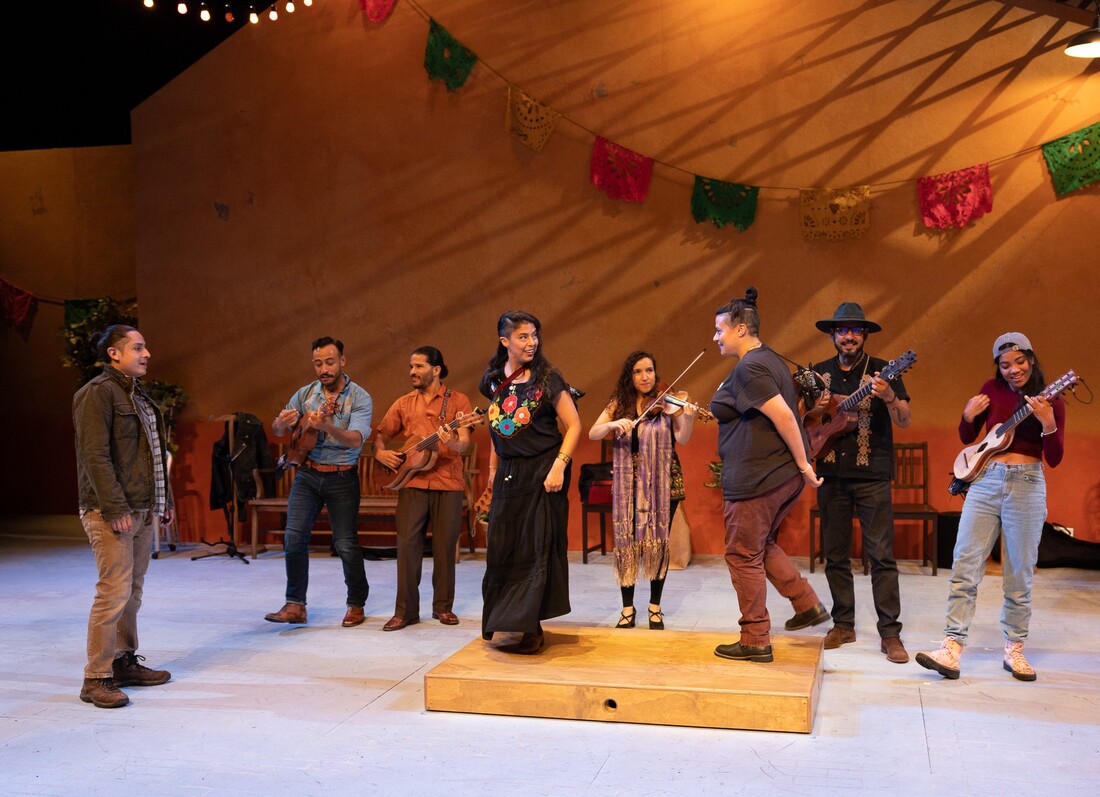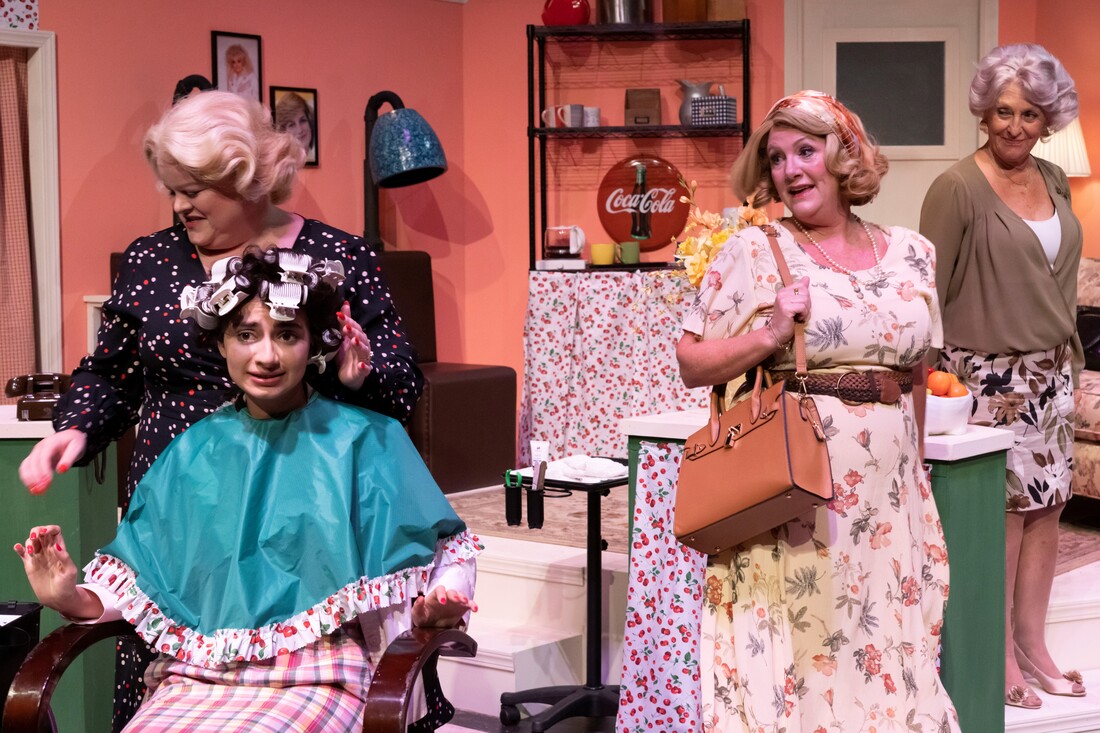|
Left to right: Greg Hildreth, Rebecca Creskoff, Sophie von Haselberg and Joshua Malina in "What We Talk About When We Talk About Anne Frank." Photo by Jim Cox Nothing like a little high-THC grass to mellow out an escalating confrontation over religion. But before we get to that, let’s backtrack.
Marrieds Debbie and Phil are happily ensconced in their spacious South Florida home with a teenage son, Trevor, all the household conveniences one could want and no inclination at all to practice their Judaism. In Nathan Englander’s “What We Talk About When We Talk About Anne Frank,” a one-act play based on his own 2012 short story, Debbie has invited a long-lost, onetime BFF for a visit. But Lauren, who she knew growing up together in Queens, is no longer Lauren. She’s Shoshana now, an “ultra-Orthodox” Jew living in Jerusalem with her husband Yerucham (formerly Mark) and their 10 children. That’s right. Ten. In this smart and flammable comedy on the Old Globe’s Sheryl and Harvey White theater in the round, it doesn’t take long for the “happy reunion” to turn pugnacious. Phil (Joshua Malina) made it clear before the visitors ever arrived that the whole thing in his mind was a bad idea. He suspects Shoshana (Sophie von Haselberg) and her spouse (Greg Hildreth) whom he detests will try to convert eager-to-please Debbie (Rebecca Creskoff) to orthodoxy. Right you are, Phil. The former Lauren and Mark portray their life in Jerusalem and their immersion in their religion in patently idyllic terms. When Debbie and Phil retaliate in defense of their secular, non-restricted life in Florida, sparks fly, with neither sharp-tongued husband holding back. Soon each couple is defining their own Holocaust, teen Trevor (Nathan Salstone) is in the fray shocking the friends from Israel with his mocking espousal of the Church of the Flying Spaghetti Monster (there is such a thing), and all pretense of a huggy reconciliation between Debbie and Shoshana is abandoned. Note: By prescription, Shoshana couldn’t hug Debbie, or anyone else, even if she wanted to. Director Barry Edelstein lets those aforementioned sparks fly indeed, but “What We Talk About When We Talk About Anne Frank” never flies out of control. It’s constantly on the brink of explosion, though, especially when Debbie and Phil’s vodka supply starts fueling the heated exchanges. Which brings us to the pass-around pot that’s broken out just in time to apparently prevent the company from bolting. The ensuing everybody’s-stoned scene is of the kind that we’ve seen a thousand times before, but it does bring welcome catharsis to the sniping and resentment in the air. The story culminates with a game for which the play is named, one that has to do with who would provide shelter for whom in the event of a second Holocaust. In this corner, Debbie. In the other, Shoshana. Edelstein previously directed Englander’s tremendous “The Twenty-seventh Man” in this space at the Old Globe in 2015. “Anne Frank” is nowhere near as engrossing, but it is a highly thoughtful play, one with the volume often turned way up. The cast is a stalwart one, with Malina making a spontaneously snide Phil and Creskoff’s Debbie desperately trying to make the whole “party” work until, provoked, she can’t try any longer. Hildreth’s Mark is relentless, while von Haselberg’s Shoshana is the play’s most nuanced and riveting character. It’s said that neither politics nor religion should ever dominate a social gathering. Well, it’s not said at Phil and Debbie’s fancy house in South Florida, but then Shoshana and Mark have a lot to do with that. “What We Talk About When We Talk About Anne Frank” runs through Oct. 23 in the Old Globe’s Sheryl and Harvey White Theater in Balboa Park.
0 Comments
The look of Bollywood is very much a part of "Come Fall in Love." Photo by Jim Cox For the record, I’ve never seen “Dilwale Dulhania Le Jayenge,” better known as “DDLJ,” the 1995 romantic Bollywood film on which the Old Globe’s world premiere musical, “Come Fall in Love,” is based. So I’m not going to make any comparisons, as ardent fans of the movie might, between it and this lavish production onstage in Balboa Park. Nor will I make a point of opining on the issue, articulated in detail recently in a New York Times article, of the musical adaptation’s reinventing the love story between two NRI’s (non-resident Indians living outside of their native country) as one between NRI Simran and a spoiled Harvard frat boy, Rog.
Instead, I’ll consider “Come Fall in Love” on face value. It’s a light-as-air (in spite of what it may be endeavoring to say about feminism and Indian identity) musical romance with prodigious sets (scenic design by Derek McLane), gorgeous costumes (by Linda Cho) and choreography of Indian dances by Shruti Merchant that evoke in sight and sound the richness of Bollywood filmmaking. The story ... I’m not especially in love with. The serious and bookish Simran (Shoba Narayan), a student at Harvard, encounters wealthy part-ay boy Rog (Austin Colby) at, what else? A part-ay, and she ends up being falsely arrested for something ridiculous having to do with flamingos. They meet again on Simran’s trip to Europe with her friends and predictably end up having to share a hotel room in Switzerland after missing a train. Nothing between them to this point suggested to me that they would fall for each other, and it’s a bit troubling that wallflower Simran’s over-consumption of complementary champagne is the first step toward her falling for Rog. He gallantly slept in the jacuzzi, not taking advantage of her. Good for Rog, but should that have been enough to turn Simran’s head? The long and short of it is by the time the Europe trip is over and Simran is bound for India to fulfill her arranged marriage there, she and Rog are pining for each other, their duet of denial, “Like You That Way.” being intentionally ironic. What happens in Act 2, the far superior of the two acts, in India comes as absolutely no surprise. This is, after all, a love story and a happy ending is preordained. Setting aside the story itself, “Come Fall in Love” enjoys some exemplary performances. As the lovers, Narayan and Colby are both pleasing vocalists and highly likable – that must not have been easy to achieve for Colby, whose first-act Rog is shudderingly vacuous, witnessed by the bacchanalian solo “Party and Spend Daddy’s Money.” Irving Iqbal as Baldev, Simran’s strict father, and Kate Loprest as Minky, Rog’s grown-sorority-girl mother, both deliver the kind of supporting performances that get awards. Iqbal’s opening number, “So Far,” for example, initiates “Come Fall in Love” with flourish and a degree of gravity, while Loprest’s presence throughout Act 2 is funny, sexy and sassy. The most touching moment in the show finds Rupal Pujara as Simran’s mother, Lajjo, comforting her daughter-at-a-crossroads in “I Give You the World.” “Come Fall in Love’s” score by Vishal Dadlani and Sheykhar Ravjiani is bold and sometimes bodacious, heard to best effect in pieces featuring Rog, the character who most evolves in this tale. Nell Benjamin’s lyrics are in that same spirit. Have to say, though, the fall in la-la-la-love refrain of the title song can only be called cutesie. Aditya Chopra, who directed “DDLJ,” directs “Come Fall In Love” as well and obviously understands the audience-pleasing dynamics that made the film such an enduring one and could be transferred to the stage. It’s counterintuitive to say that a two-hour, 45-minute production moves crisply because it really doesn’t, but there aren’t any draggy spots in “Come Fall in Love.” A couple of expendable songs? Maybe so. “Come Fall in Love” isn’t precisely Bollywood onstage, but it possesses enough of Indian cinema’s vibrancy and energy to satisfy those devoted to it. “Come Fall in Love” runs through Oct. 16 at the Old Globe Theatre in Balboa Park. The ensemble of "Fandango for Butterflies (and Coyotes)." Photo courtesy of La Jolla Playhouse One precisely choreographed sequence in “Fandango for Butterflies (and Coyotes)” articulates the full reality of the immigrant experience: the desperation for a better life, the danger, the struggle to survive. In a matter of a few minutes’ time, with cast members in perpetual motion, a world spins out of control.
But there is sanctuary: a community center on the grounds of a church in Chula Vista where men and women who have escaped the hardships (and worse) of their native countries and fled to America gather to sing, dance and tell stories. This is the setting for a bilingual play with music by Andrea Thome and Sinuhe Padilla. “Fandango” is a production of New York-based En Garde Arts that’s being presented by La Jolla Playhouse under the direction of Jose Zayas. Writer Thome based her characters on interviews she did in the New York City area (the play’s original setting). They are portrayed onstage in La Jolla by a fiercely committed ensemble doing double duty as actors and musicians with instruments. Padilla’s accompanying music, sung in Spanish, is alternately invigorating and affecting. Because this is a bilingual piece, screens with translated words (either from Spanish into English or the other way around depending on the moment) are positioned to the left and right above the stage. I found them more distracting than helpful, and I’m not entirely certain they’re needed. The passions and essence of the numbers sung in Spanish speak for themselves. To fully appreciate “Fandango” it would be best to actually be bilingual, and I sorely longed to be during the 90-minute show. In fact, as a Southern California native, I should be. I am blessed to live among two rich, intersecting cultures and there is no excuse for my not being more conversant with the language of those who share my region. Enough of me. The interweaving personal stories of “Fandango” are compelling ones: Rogelio (Carlo Alban) and Elvin (Danny Ray Caraballo) are stable workers, each bearing the burden of painful truths: Rogelio, from Honduras, has not seen his daughter in almost a decade; Elvin wears a monitor shackled to his angle, a reminder that deportation could come at any moment. Mari (Jen Anaya), the play’s anchor character, has a mother in failing health; Rafaela (Silvia Dionicio) is a teenager long abandoned by her mother. And yet there is hope and affection in all of them, expressed either in words or in song. The anxious plot points of “Fandango” run much more intricate than this, however, suggesting that the play overreaches and never attains tonal consistency. It can be starkly poetic, as when Elvin’s cousin Johan (Roberto Tolentino) recites in monologue; playful, as when the likable Pili (Frances Ines Rodriguez) breaks down shy Rafaela’s barriers; wistful, as when Rogelio sincerely courts Mari in vain; and as exultant as the song and dance that at times fills the Mandell Weiss Forum with percussive energy. Maybe that’s why “Fandango for Butterflies (and Coyotes)” feels one draft away from completion though it debuted back in 2020 in New York City’s boroughs. Even as is, it’s a story that can never be told enough – at least until grave wrongs are righted and those who long to share the freedoms that we cherish are welcomed and respected. “Fandango for Butterflies (and Coyotes” runs through Sept. 25 at La Jolla Playhouse. Left to right: Wendy Maples, Liliana Talwatte (seated), Marci Anne Wuebben and Dagmar Krause Fields in "Steel Magnolias." Photo by Daren Scott At first blush, “Steel Magnolias” would seem to be a leisurely tale about six Southern women just sittin’ around and talkin’ in a small-town hair salon. As anyone who’s seen a production of Robert Harling’s 1987 play (or the 1989 film adaptation) will tell you, it’s about much more than that. Woven into the gossip and interpersonal business of life in fictitious Chinquapin, Louisiana, are warm reflections on friendship and sacrifice.
Backyard Renaissance Theatre’s current staging of “Steel Magnolias” directed by Anthony Methvin demonstrates a keen appreciation for the play and its richly drawn characters. This is accomplished by letting the narrative unfold at its required relaxed (if at times dawdling) pace and by allowing the cast to establish its chemistry over time. Done and done. Truvy (Wendy Maples) is the anchor of “Steel Magnolias,” proprietor of the salon and earnest purveyor of advice for all. At the opening of the play she’s taken on a young, eager-to-please assistant, Annelle (Claire Kaplan), who is nervously guarding secrets. The gossipy Clairee (Dagmar Kruse Fields) is a regular presence at Truvy’s as is M’Lynn (Marci Anne Wuebben) and her daughter Shelby (Liliana Talwatte). The caustic Ouiser (Annie Hinton) pops in and out, armed with tart remarks and harmless grousing. The first sign of unease in the otherwise friendly confines of Truvy’s comes with Shelby’s preparation for her wedding – and her mother’s unsolicited advice about anything related to it. The M’Lynn-Shelby relationship will prove to be the crux of “Steel Magnolia’s” drama and the nexus of its poignancy. Talwatte, underutilized in Backyard Renaissance’s production of “Abigail’s Party” earlier this year, endows Shelby with a sweetness – but not a sugariness – that makes her easy to root for. In the play’s most complex characterization, Wuebben beautifully navigates the most emotional of “Steel Magnolia’s” waters. The fact is, all these characters are likable in their own way, and thankfully the script isn’t overburdened by each of them having substantial back stories. The enigmatic Annelle comes closest, but her conflicts are shunted off into born-again gesturing. Kaplan, so alluring and exciting as Picasso’s model in OnStage Playhouse’s recent production of Charles Borkhuis’ “Blue Period,” shows her versatility with “Magnolias.” She’s the outsider who becomes an insider, not unlike what playwright Harling may have wanted for audiences. Its vivid characters aside, “Steel Magnolias” does demand more than a degree of patience from us. These women may hurry their opinions but they don’t hurry their stories. The atmosphere inside Truvy’s is loving but languid. On opening night at the 10th Avenue Arts Center downtown, the temperature outside was near 90 and it couldn’t have been much cooler inside until the A.C. kicked in, an inconvenience that the folks at Backyard Renaissance earnestly apologized for. Then again, the swelter fit the play. While fanning yourself, if you closed your eyes you could almost smell the magnolias abloom. “Steel Magnolias” runs through Sept. 17 at the 10th Avenue Arts Center, downtown. |
AuthorDavid L. Coddon is a Southern California theater critic. Archives
July 2024
Categories |
David Coddon |
|



